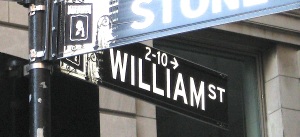 The Algonquin Round Table of the 1920s. The Bohemian crowd at Pfaff’s in the 1850s.
The Algonquin Round Table of the 1920s. The Bohemian crowd at Pfaff’s in the 1850s.
New York writers have always organized formal and informal clubs where they could share their wit and their work—over alcohol, of course.
The Lantern Club was one of these. Now just a footnote in the city’s literary history, the Lantern (sometimes called the Lanthorn) was founded in 1893. Its headquarters, an old house on William Street near the newspaper offices of Park Row, was fashioned to resemble a ship cabin.
 Prominent members included Stephen Crane (left, in 1899), the young, struggling author of Bowery tale Maggie: A Girl of the Streets. Mark Twain and Theodore Roosevelt occasionally dropped by.
Prominent members included Stephen Crane (left, in 1899), the young, struggling author of Bowery tale Maggie: A Girl of the Streets. Mark Twain and Theodore Roosevelt occasionally dropped by.
Crane and his cohorts didn’t just sit around and booze. They actually shared their work during regular literary banquets held every Saturday evening.
“Each week at the banquet, one of the members read a short story he had written,” writes Stanley Wertheim in A Stephan Crane Encyclopedia.
“Only negative criticism was permitted, and ‘the highest tribute that a story could receive was complete silence.'”
Stephen Crane died in 1900 of tuberculosis at age 29. When the Lantern bit the dust, however, is a mystery.





